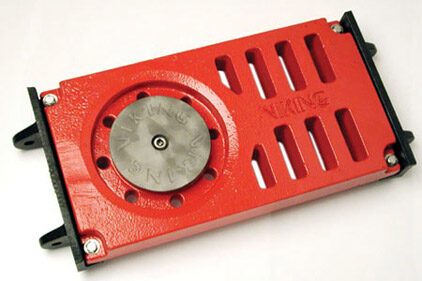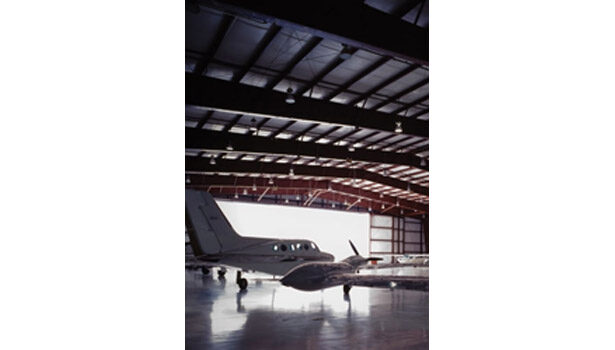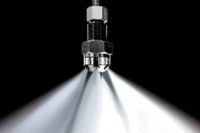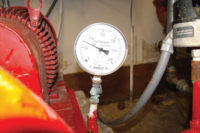Yes, I mean the one where the hangar doors were opened afterward and the foam seemed to flow out onto the aircraft operations area, almost engulfing a small jet sitting outside the hangar.
If you have not worked with an aircraft hangar or similar high-value storage facility, you may not have heard about the continuing evolution in foam fire suppression methods. Desired suppression systems in aircraft hangars are shifting from low-expansion (dense) foam discharged overhead to high-expansion foam discharged overhead or low-expansion foam discharged at the floor level.
Any of these systems are still being combined with ceiling water sprinklers in either open sprinkler (deluge) configuration, or in a wet pipe, closed/fused sprinkler configuration. Because the sprinkler droplets will have a deleterious effect on the foam blanket, extra foam discharge is calculated into the design to compensate. Water from sprinklers also will have a cooling effect because the foam smothers a fire. The result is the fire is usually extinguished, but there is foam residue and water left on the floor, on any equipment in the area and in the floor spill containment system.
Agents/Systems
High-expansion foam systems are considered by many to be the most effective systems with the lowest impact on a facility and its contents. High-expansion foam flows to smother low-level fires. Low-expansion, aqueous film-forming foam is still in strong use, but its application has changed from being discharged high above the hangar floor from foam generators to being sprayed from grate nozzles at floor level. FM-approved in 2003, the Viking Grate Nozzle System continues to provide an effective application of AFFF at the floor level instead of being discharged from high-level foam generators. NFPA 409 — Standard on Aircraft Hangars — gives guidance on application combinations that include those described herein.
Hangars
Without restating all hangar classifications mentioned in NFPA 409, Class I hangars require the highest level of suppression protection of Classes I, II and III. Class I hangars may be protected by:
1. A foam-water deluge system with supplementary suppression system; or
2. A combination automatic sprinkler system and low-level, low-expansion or low-level high-expansion foam system.
The obstacles to fire suppression in hangars include suppressing fuel fires under wing shadows and still protecting the high-value aircraft and its sensitive electronics. Given that AFFF is a low-expansion foam and tends to flow in a blanket over a fuel spill, smothering fires and re-flash, it is effective when discharged at floor level under fixed-wing as well as rotary-wing aircraft. High-expansion foam is effective due to it being a less-dense foam that floats to suppress fires above and below wing shadows.
Solution Containment
As we strive to protect the environment from spills, containment of runoff from suppression agent discharge is a serious concern. Usually, one would think this means suppression agent spills and discharge. However, potable water also is a threat to the environment because it upsets the ecological balance of the area and groundwater surrounding a facility.
Therefore, we size containment to accommodate water and agent discharge unless site-specific codes allow otherwise. That can mean a containment tank size starting at 30,000 gallons for a moderately sized hangar with an AFFF floor grate nozzle system and overhead wet pipe sprinklers. Naval facilities standards for hangars include UFC 4-211-01N, which does not require containment tanks to be sized for hose or sprinkler runoff, only suppression agent solution due to accidental foam system discharge.
Foam systems are only required to have enough suppression agent for 10 minutes of discharge and, therefore, require limited containment volume. Sizing containment tanks to accommodate foam solution, as well as sprinkler runoff and hose stream runoff would mean an almost unlimited tank size because sprinklers and hoses are not limited to a finite run time due to their dependency on manual shutoff in most instances.
System Options
A low-flow water option not yet accepted as a primary suppression system in replacement of wet pipe sprinklers is on the horizon. Victaulic’s Vortex system is a fine water mist and nitrogen mixture used for total flooding, but is not currently appropriate for a four-story hangar because the application is limited by hangar volume as well as hangar height. Surprisingly, the mist cloud moves fast enough to overcome open doors, but within limits.
Floor grate and localized misting technology is continuing to evolve and appears to present the lowest impact on containment size and environmental impact. Maintenance of misting systems and water quality still remain a factor in long-term misting system costs and reliability. The current applications of overhead wet pipe sprinklers, combined with foam suppression systems, are proven to be the most reliable.




